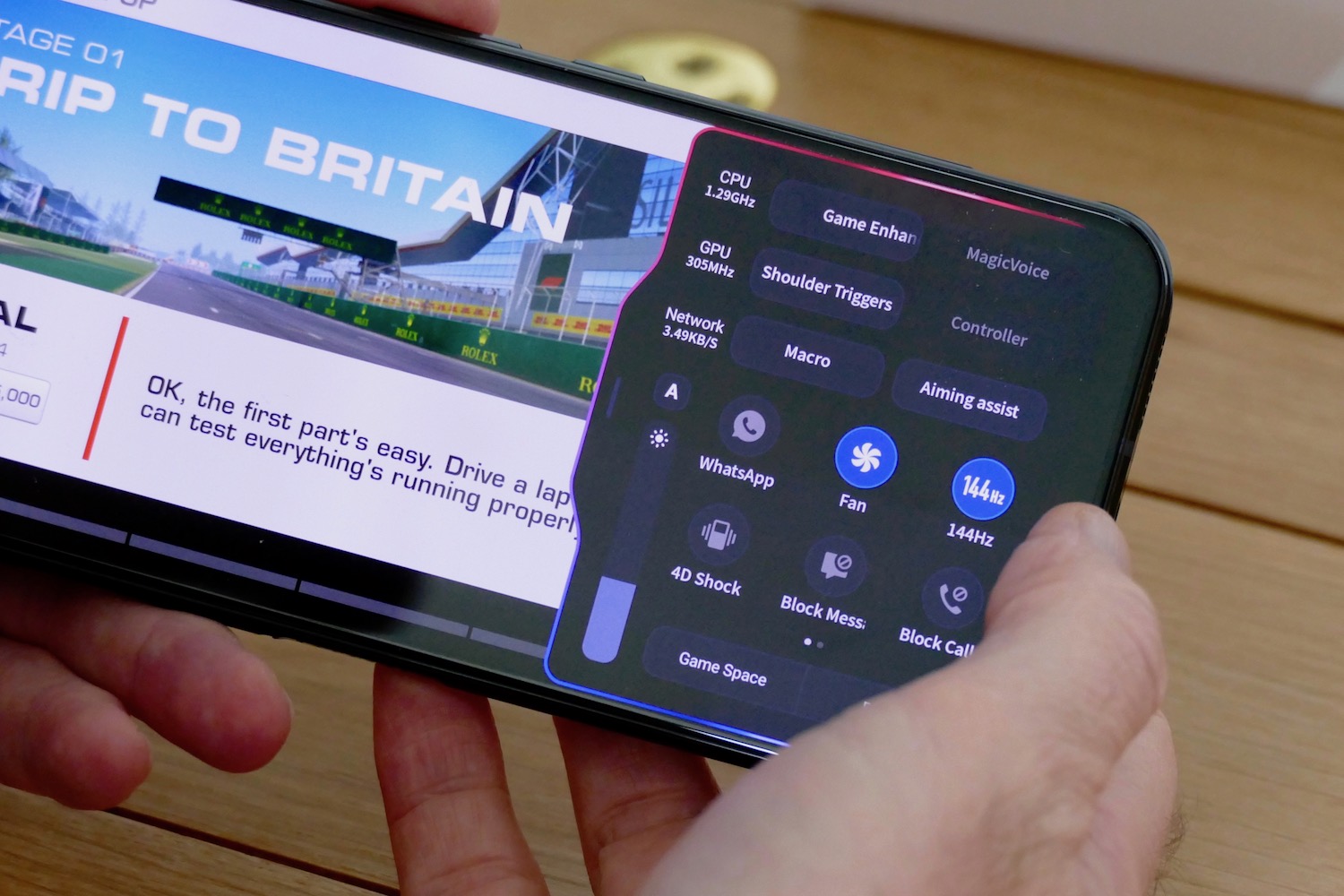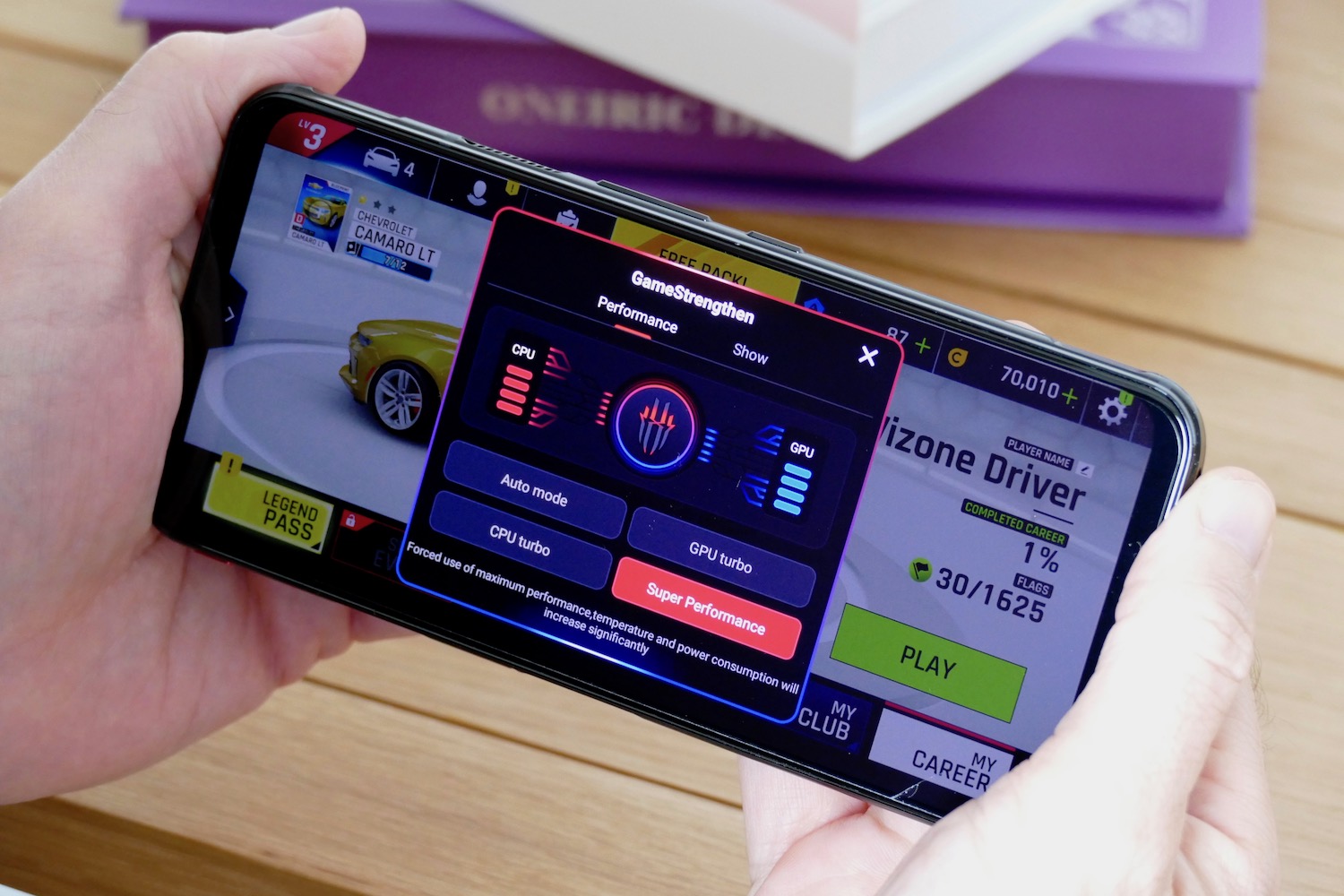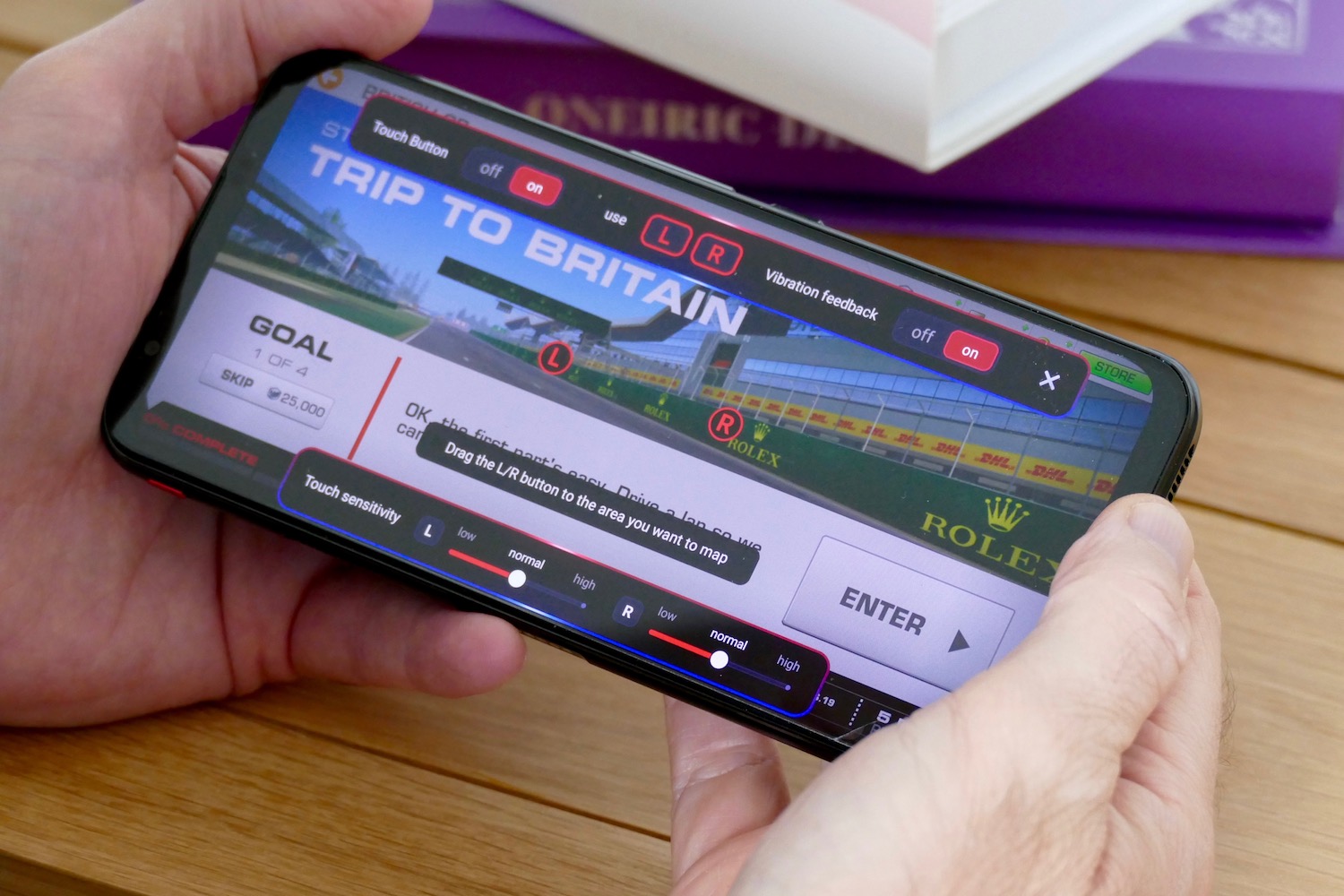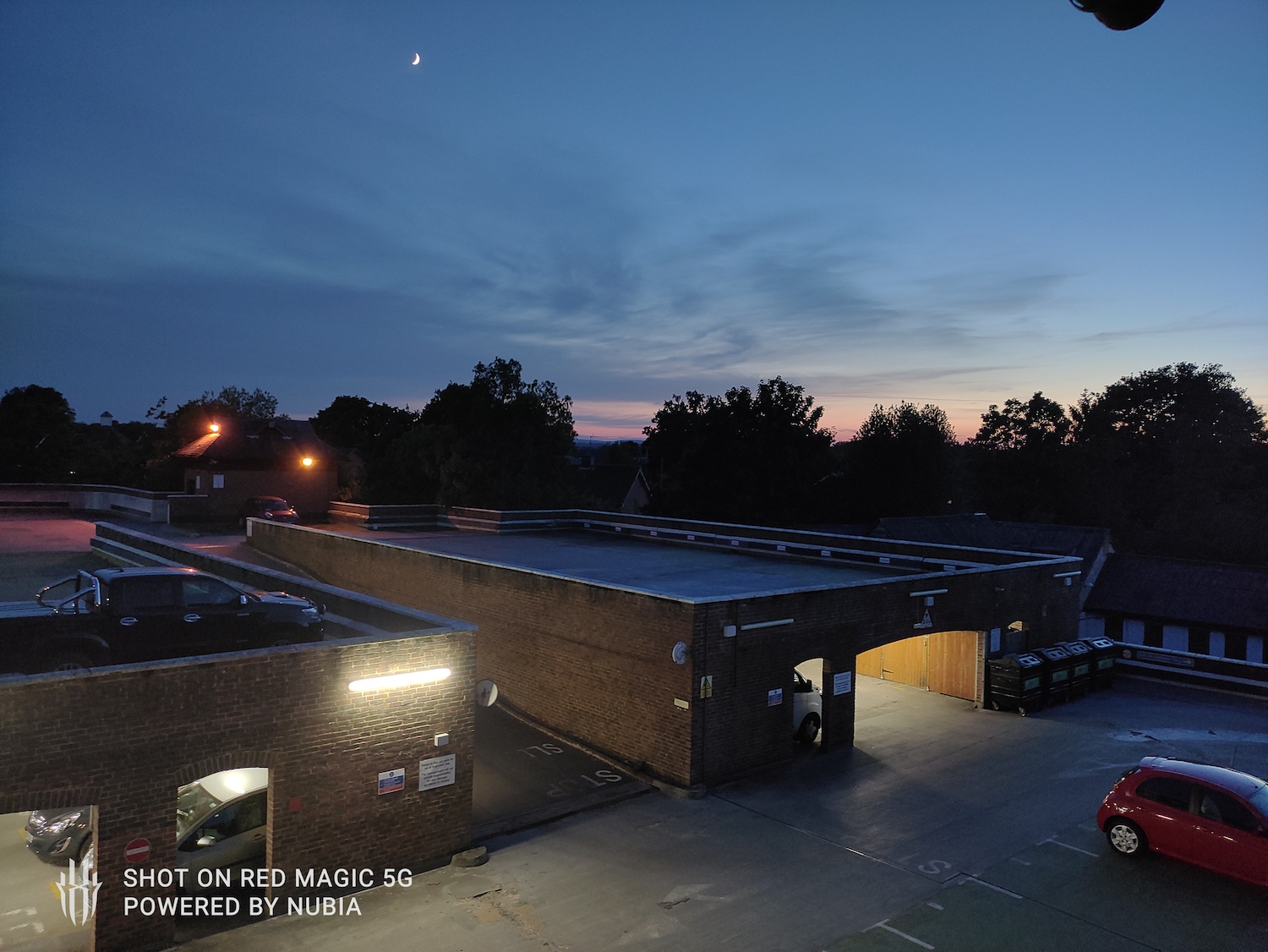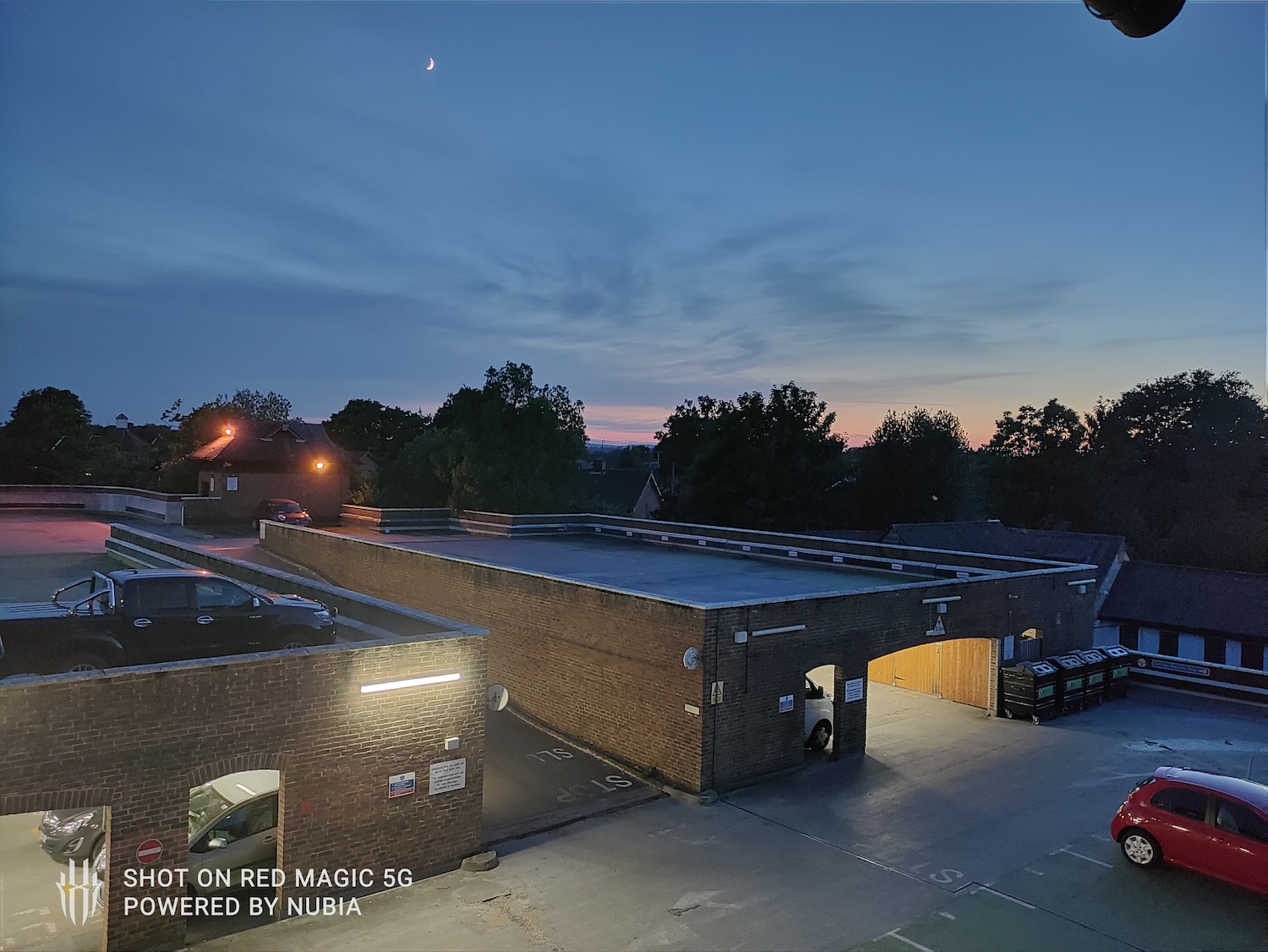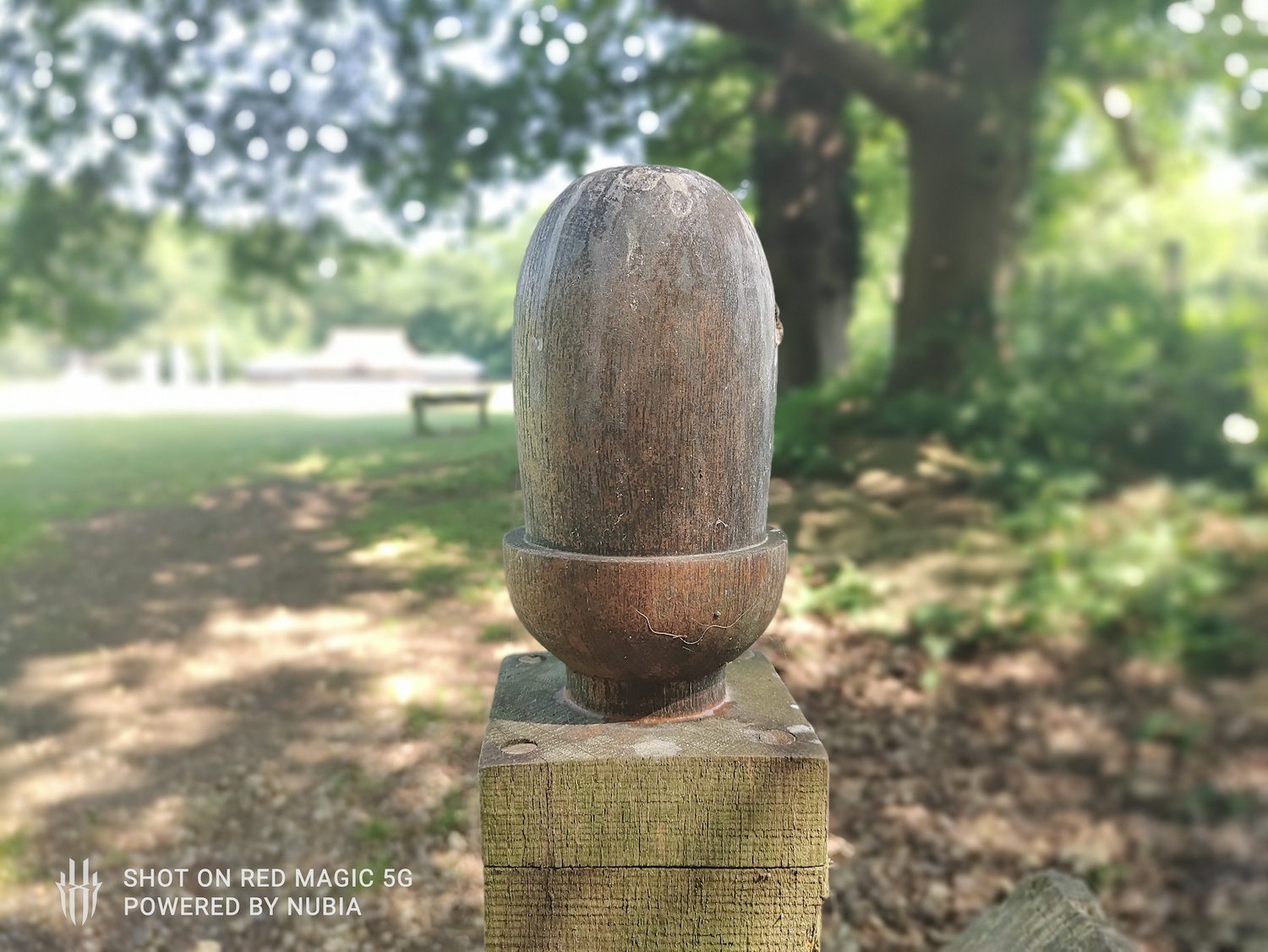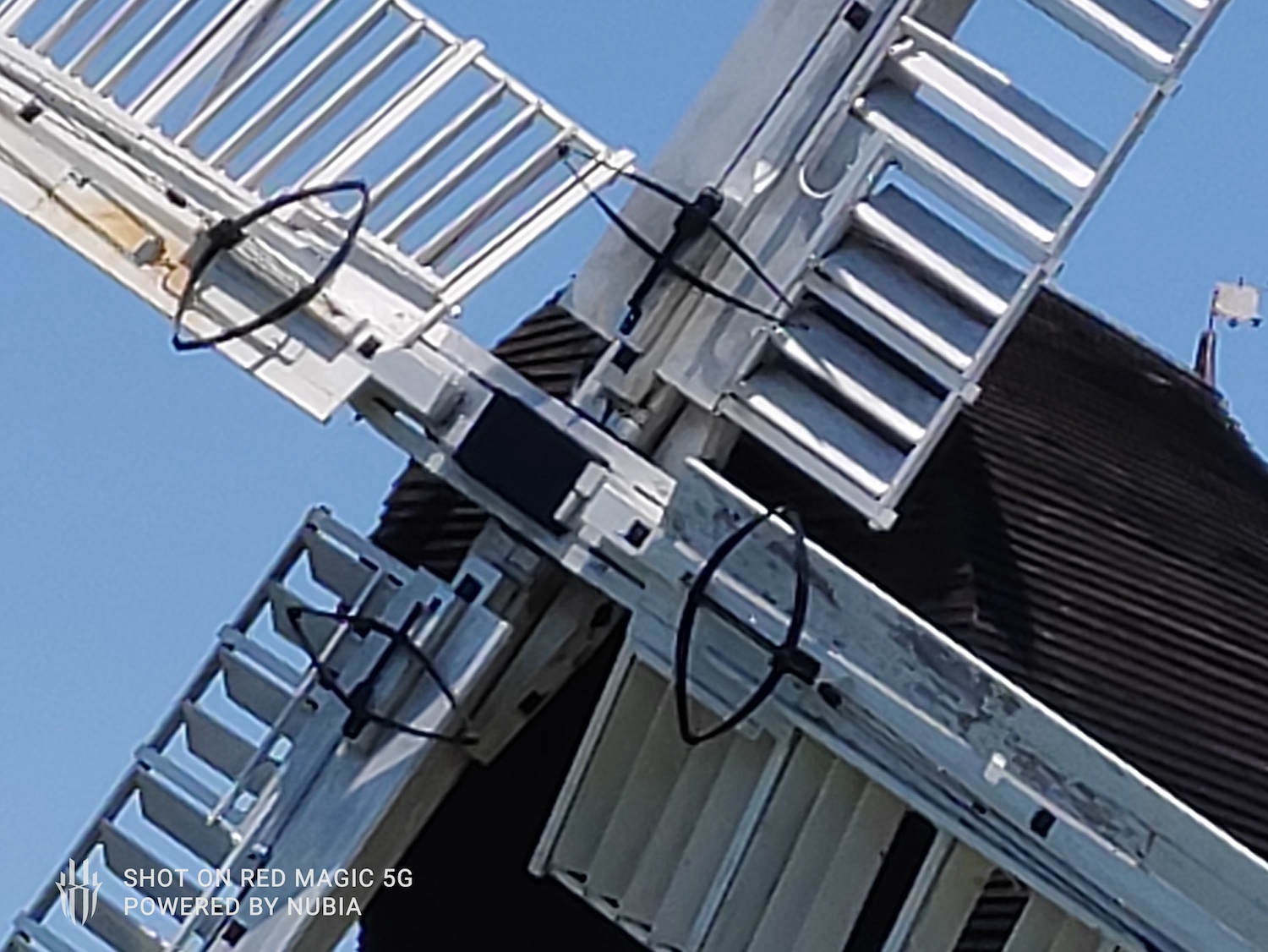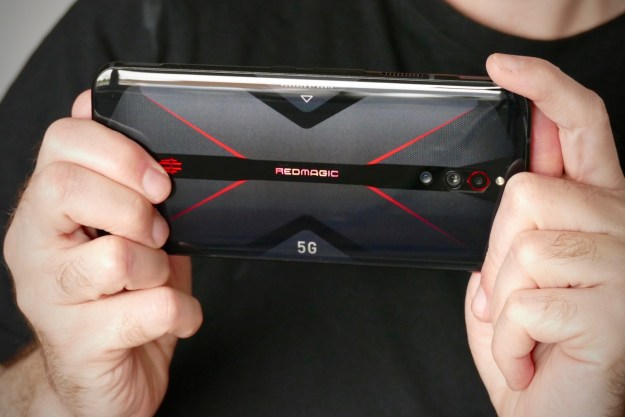
“A good value gaming phone provided games are your number one priority, but it lacks the polish needed to be a strong everyday device.”
- Good gaming-focused design
- Excellent multimedia ability
- Plenty of performance
- Long battery life
- Mediocre camera
- Poor software experience
- Fingerprint sensor does not work
The Nubia Red Magic 5G gaming phone is a tempting purchase with flagship specs for just $579, but buying a gaming phone is a big decision. You might want it mostly for games, but it almost certainly needs to do other things as well. That includes taking photos, making calls, using social networks, and more.
You’ve got to live with it every day, so it needs to do everything any other phone does, in addition to satisfying your gaming requirements. The Red Magic 5G will fulfill your gaming desires, but it falls short elsewhere.
Design
There’s no doubt the Red Magic 5G is a gaming phone. It has cooling vents down the side, a sci-fi design on the back, and the biggest giveaway of all — the Red Magic logo lights up. My review model is in Eclipse Black, which is a bit understated, but the Hot Rod Red and Pulse versions are much brighter, and more in keeping with what I’d expect from a gaming phone’s design.

This is no featherweight. It weighs 218 grams, and it’s 9.8mm thick, too. While this would normally be excessive for a “normal” smartphone, like the 220 gram Samsung Galaxy S20 Ultra, it’s quite welcome on a gaming phone, as the size makes it easier to grip and hold. It’s not so heavy that it will cause any fatigue, and is still lighter than the monster 240 gram Asus ROG Phone 2.
Despite the vents, buttons, and lights, the Eclipse Black Red Magic 5G is a little dull to look at, and some of the visual elements are haphazard. The triple-lens camera housing is small and full of mismatched shapes, with a bump only around two of the lenses rather than all three. The phone shouts “5G’ on the back, which is unpleasantly cheap looking. I do like the textured, bright red Game Space key on the side of the phone, which feels great.

On the opposite side from the Game Space slider are the power button and the volume rocker. I usually pressed the volume down button instead of the power button, which I feel is placed too low on the side of the phone. The placement is compromised because of the cooling vents and two additional shoulder buttons on the same side.

Holding the Red Magic 5G in landscape orientation is extremely comfortable due to the excellent balance, rounded corners, flat screen, and chunky body. Portrait orientation is not so comfortable as the phone is not only thick but also just a tiny bit wider than even the Asus ROG Phone 2 and the Samsung Galaxy S20 Ultra. The Red Magic 5G serves its intended audience well, but as an everyday tool, it loses marks.
Screen
The Red Magic 5G has the world’s first 144Hz refresh rate screen on a smartphone. It’s a 6.65-inch AMOLED with a 2340 x 1080 pixel resolution, and a 19.5:9 aspect ratio. It also has a 240Hz touch sampling rate for faster response.
Let’s talk about the 144Hz refresh rate. Yes, you notice the difference going from 60Hz to 90Hz or 120Hz, but things get much harder to spot going from 90Hz to 120GHz, and from either of those to 144Hz.

The Red Magic 5G works at 90Hz most of the time, and it’s very easy on the eye. Higher refresh rate screens really should be on all phones today, as they make scrolling and gameplay more pleasant. But is 144Hz overkill? The setting kicks in when you play games optimized for the Red Magic 5G, of which there are a handful at the moment. Real Racing 3 is one, and although there’s no denying it’s incredibly smooth, I’m not sure I noticed a huge difference when I compared it to playing on the 90Hz OnePlus 8 Pro or 120Hz Asus ROG Phone 2.
Watch video with the screen settings at default, and colors are a little washed out and lacking detail, especially compared to the iPhone 11 Pro. Go into the Settings menu and select the DCI-P3 color gamut option, and everything gets more saturated, and detail is further obscured in the deeper blacks. I’m nitpicking a little here, as it’s otherwise a great phone for games, media, and video. The stereo speakers are loud and there’s plenty of bass response, to the point where the back of the phone vibrates in your hand.

There is a sizable bezel around the top and bottom of the screen, which again isn’t preferable on most phones, but does make it easier to hold and manipulate in landscape — something gamers want. It’s the same reason most will be pleased it doesn’t have a curve at the sides. This makes controlling games much more natural, but does affect how modern the phone looks.
Gaming
Real Racing 3 presents the Red Magic 5G with a challenge. Activate Game Space, and you can toggle the 144Hz refresh rate to on. I played it in both Auto and Super Performance mode, where it maxes out the CPU and GPU’s abilities. The game plays superbly with no difference between minute one and minute 60 in terms of speed, smoothness, and enjoyment. However, the phone does get hot.

The Red Magic 5G has an active, multi-layer cooling system with a fan (a real, whirring fan you can hear spinning) inside for exactly this kind of situation. It didn’t make much of a difference to the surface temperature of the phone, especially along the sides of the chassis, but I suspect it cools the components inside effectively, as performance never changed. The sound of it in action is a bit distracting, though.
I played Real Racing 3 on the Red Magic 3, the OnePlus 8 Pro, and the Asus ROG Phone 2 for comparison. The game looks better on the Red Magic 5G than it does on the OnePlus, generally brighter and more attractive, and with improved response. However, it can’t compete with the ROG Phone 2. The Asus phone’s 120Hz screen is stunning, it has forward-facing stereo speakers which sound excellent, and the Asus phone’s tilt controls are more responsive than either of the other two. I was a better, faster driver playing on the ROG Phone 2. The ROG Phone 2 is almost twice the price of the Red Magic 5G, but it does show.

There are two capacitive shoulder buttons on the phone, which work with Asphalt 9: Legends for drift and boost control. They are responsive and easy to press and locate with your finger, plus they were easy to configure with most games. Using them keeps your fingers off the screen. The Red Magic 5G has a 240Hz touch sampling rate, for lighting fast reactions to your taps and swipes, while the shoulder buttons go beyond this to 300Hz.
Is the Red Magic 3 all about graphically intensive, processor-heavy games? I spent time playing Game Dev Tycoon with the Game Space active, and although the fan kicked in occasionally, it never seemed to tax the phone in any way. Playing it on the Red Magic 3 was no different than playing it on any other high-end smartphone, outside of the very comfortable body, which throughout my review has never caused any fatigue when holding it in landscape orientation.
Game Space is switched on using a physical slider on the side of the phone. It works as a menu for your games, and a slide-in panel adjusts the phone’s GPU and CPU performance, sets up the Pro Trigger shoulder buttons, activates the fan, the 144Hz refresh rate, and minimizes notifications too. It also has a programmable macro mode to perform complex functions quickly, plus a screen recorder system. I don’t like the way it suddenly boosts the in-game volume when you activate it though, as it just made me turn the volume down each time. If I want the volume up, I’ll turn it up myself.
Overall, gaming on the Red Magic 5G is a highly enjoyable experience, with the excellent visual and audible performance adding a lot to my favorite games, and pushing me to play more.
Software
My review Red Magic 3 had Android 10 with the March 2020 security update installed, and version 2.0 of the Red Magic OS user interface over the top. If you’re expecting the phone to have software as slick as a Google Pixel 4 or OnePlus 8 Pro, then prepare for disappointment. Red Magic phones come from device manufacturer Nubia, which was once part of the ZTE empire, and the resemblance to dodgy Android UIs on Nubia and old ZTE phones is sadly still there to see.
Icons are large, stylized, and often mismatched, with some more curved than others. It makes the home screen look cheap and messy. Although there is an app drawer, the phone still spreads app icons across multiple home screens, so you end up having to clean everything up yourself.
The Always-on screen is customizable and shows a clock and battery level, but it does not show notification icons. On the home screen, only some icons have notification counters, like Messages, but others like WhatsApp do not. Email notifications aren’t grouped in the notification shade either, resulting in a long list that’s not especially useful to look at. It’s full of other little quirks, like alerts not having an OK option to dismiss, but an “I know” button instead.
The way the phone deals with notifications is frustrating. It made me check my phone more because there was no way to know at a glance if a message was waiting. Otherwise, I didn’t experience compatibility or performance problems, I like the swipe-in Google News panel, and Game Space works well, plus plotting the shoulder triggers to particular functions in a game is simple and effective. It’s unfortunate the everyday aspects make me trust the phone less, which in turn makes me not want to use it.
Camera
Obviously Red Magic’s focus is on gaming, and at this price, other aspects of the phone may not get quite the level of attention they deserve. The camera seems to be one of them. The main sensor has 64 megapixels, the wide-angle sensor has 8 megapixels, and the macro lens has 2 megapixels. On paper, it’s a mid-range setup that should still be capable of delivering some decent photos.

In reality, it still needs work. The main problem is dynamic range, with the phone finding it hard to deal with shadows and exposure, especially when the lighting is awkward. Shots on sunny days lost a lot of detail or amped up the saturation too much, while some indoor photos messed with the colors. A photo I took of cooking rice turned it yellow, when there was no yellow present at all, for example.
The phone’s software promotes a 3x, 5x, and a 10x zoom function, but these appear to be entirely digital, and the quality above 3x is poor. Don’t be fooled into thinking the Red Magic 5G is going to challenge the Huawei P40 Pro’s mega-zoom ability. There is a wide-angle mode too, but weirdly the setting is only accessible in Pro mode. The results are solid, so it’s a shame many may miss its existence entirely. There is a wide variety of bizarre camera modes hidden away too, from a multi-exposure mode to “Phantom,” which adds an odd motion blur effect to videos. They’re all entirely forgettable.
Don’t buy the Red Magic 5G thinking the camera is going to be anything more than average. While I’d like it to be a lot better, I appreciate it’s not what the phone is about. So long as you do too, you won’t be disappointed.
Performance, battery, and Security
A Qualcomm Snapdragon 865 processor is the Red Magic 5G’s source of power with either 8GB or 12GB of RAM, depending on the version you buy. My review model has 8GB. Here are the benchmark results:
Geekbench 5: 3222 Multi Core/902 Single Core
3DMark Sling Shot Extreme: 6702 (Vulkan)
These figures are in line with those produced by the Xiaomi Poco F2 Pro, the Xiaomi Mi 10 Pro, and the OnePlus 8 Pro, all of which have the same Snapdragon 865 processor. The Red Magic 5G’s scores beat the Exynos-powered Samsung Galaxy S20 Plus. I have experienced no problems with the phone’s performance, and calls have been fine, but I have not tried the 5G connection due to movement restrictions and not having a 5G service in my local area.
Under the screen is a fingerprint sensor. This has refused to register my fingerprint at all, rendering it completely useless. Although my software version claims to provide a face unlock feature, it is not present. I have spoken to Red Magic about this and have been told if a software update fixing these problems is available for my device, it will be pushed through. However, it has not arrived at the time of writing. My Red Magic 5G can only be secured using a PIN or pattern.

The battery life has been strong, with the phone lasting for a full day even after several hours of gaming on top of my usual activities. With more general use it lasted for almost two full days. The charging doesn’t match up though, as although Red Magic says the phone supports 55W fast charging, you have to buy a special charger sold separately to carry it out. Otherwise, you make do with the 18W charger in the box which takes almost two hours to charge the 4,500mAh cell. Disappointing, and there is no wireless charging either, plus the USB Type-C port is conventionally placed on the end of the phone, unlike the side port on the ROG Phone 2 for improved ergonomics.
Price, warranty, and availability
You’ll pay just $579 or 539 British pounds for the 8GB/128GB Red Magic 5G phone I reviewed here, or you can splash out $599 or 599 British pounds for the 12GB/256GB version. It’s best to buy the phone through Red Magic’s own website so you take advantage of the manufacturer’s warranty, which covers it for a year in the U.S. and two years in the U.K.
Our Take
The Red Magic 5G does what it was built to do — play games — very well, and is decent value considering the hardware. However, outside of gaming, the phone disappoints on several fronts, including the camera, slow battery charging, and software.
Is there a better alternative?
Yes. If all you want to spend is around $600 or 600 British pounds, take a look at the OnePlus 8 and the Poco F2 Pro. Both share the same processor as the Red Magic 5G, while the OnePlus 8 also has a 90Hz refresh rate screen and a more stylish design. Both have cameras that are better than the Red Magic 5G, but obviously lack the gaming-centric features like the shoulder buttons.
If a gaming phone is top of your list, the Asus ROG Phone 2 still rules despite being almost a year old. We recommend waiting to see if Asus releases a sequel in the near future though, as there are rumors one will arrive before the end of the summer. It’s also a lot more expensive than the Red Magic 5G, and if price is no object, putting the iPhone 11 Pro at the top of your list is our recommendation due to the wealth and quality of the games available for it.
How long will it last?
See those vents on the side of the Red Magic 5G? They should give you a clue as to the phone’s ability to withstand water. That’s right, there’s no IP rating here, and the glass back and hefty weight means it probably won’t be great in a long fall either. Treat it with care.
With 5G and the Snapdragon 865 plus the high-spec screen, the phone should stay fresh for some time. However, if you have aspirations of using the phone for a lot of photography now or in the future, it may not serve your needs very well. But if all you want to do is play games, then the Red Magic 5G has you covered for several years at least.
I asked Red Magic about software updates. Apparently the phone will get Android 11, but there’s no timeframe at the moment. The team also says it will push general software updates to the phone every two months.
Should you buy it?
No. The Red Magic 5G is a good gaming smartphone, but it’s not a great everyday smartphone.
Editors' Recommendations
- Visible’s affordable 5G plans just got even cheaper
- Visible just made its unlimited 5G plan better than ever
- How fast is 5G? What you need to know about 5G speeds
- Have T-Mobile? Your 5G service is about to get much faster
- Your next phone could get a huge 5G upgrade, thanks to AI

